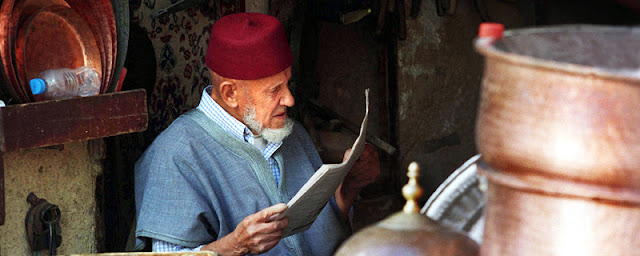 Vipera lebetina - (Photo credit: Friml & Preiss)
Vipera lebetina - (Photo credit: Friml & Preiss)Snake bites are responsible for a high mortality rate in Africa where the overall mortality of bites is around 4%.. Problems for the early care of the victims are many due to lack of medical services with serum in isolated locations..
In the Morocco bites are often caused by the lebetin viper (Vipera lebetina) or the horned viper or sand viper (Cerastes cerastes).
Vipera lebetina.
A very corpulent viper, well camouflaged and often just laying on the ground near or even in small water pits, waiting for birds to approach. When passing the snake, it usually doesn't move, what makes it easily overseen by hikers.
Identification:
This matt greyish to dun-brown coloured snake is very corpulent and can reach the thickness of an arm. Adults usually reach a length of approx. 130 cm, rarely up to 160 cm. Like all vipers it has keeled scales on the body where they are larger than on the head. Three very small black spots on the head are typical for this species.
Cerastes cerastes
The average length is 30-60 cm, with a maximum of 85 cm. Females are larger than males.
One of the most distinctive characteristics of this species are the supraorbital horns, one over each eye. However, these are either present, reduced in size or absent.
The colour pattern consists of a yellowish, pale grey, pinkish or pale brown ground colour that almost always matches the substrate colour where the animal is found. Dorsally, a series of dark, semi-rectangular blotches run the length of the body. These may or may not be fused into crossbars. The belly is whitish and the tail may have a black tip.
Treatment
Immunotherapy remains effective against haemorrhage, even when administered late, in severe disease (bleeding). Death remains inevitable if antivenin is not being administered or if it is at the stage of multiorgan failure.
Heparin is contra-indicated in the acute context, but at distance from the bite, the persistence of inflammatory syndrome can cause phlebitis or pulmonary embolism. Fresh frozen plasma and corticosteroids are ineffective and unnecessary.
Signs of gravity are rapidly extensive swelling and systemic manifestations, particularly bleeding. The severity of poisoning is related to the difficulties of access to health centres, the use of traditional medicine for more than half of the victims, the lack of training of caregivers, finally and most importantly, the lack of anti-venom serum,that is not within reach of prescribing at the appropriate places and times. Despite its cost and allergic risk (become rare with the current serums), immunotherapy which is the only weapon effective against the venom, should be part of emergency essential drugs if spending a long time treking.
For more interesting info: http://www.moroccoherps.com


5 comments:
Excellent article and equally good scary photos!
Very informative,
Des Clark aka Nomad
http://nomadicmorocco.blogspot.com
I Killed one couple of weeks ago.
Well, people should pay attention especially in dry places. :)
Very informative article. We saw a large one above Amizmiz, near Azgour just 2 months ago. Last year we also saw a brown cobra in the Oued Draa out in the Sahara. They are around, but very seldom seen.
Kris Palmer
www.highcountry.co.uk
All the snakes aren´t venomous in Morocco, and snakes are peace animals. They avoid to meet with humans so I think it´s bad to kill them.
Dogs kill many many times more people than snakes in Morocco, and we don´t kill all the dogs. Each animal has a function in nature. So we should respect snakes, one of the most interesting things in Morocco.
Here is possible to find very interesting info: www.moroccoherps.com
i think it is a foolish idea to be afraid of snakes as a danger to be eliminated . first because we should see them as creatures that lives like other living beings . Second we are responsible 100 % because usually we invade their places like forests, revers sand etc . and if we can not pay attention while invafin their world it s obviously that they will attack .
Post a Comment